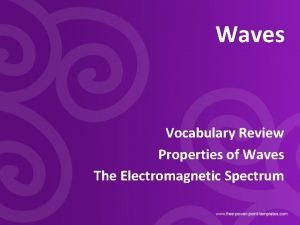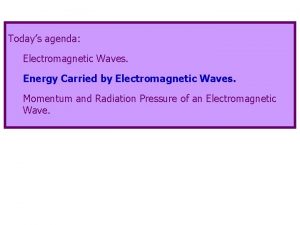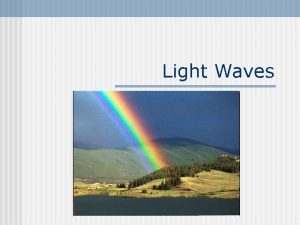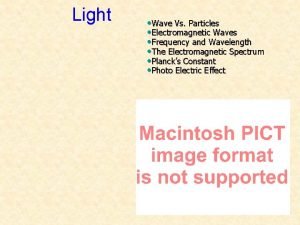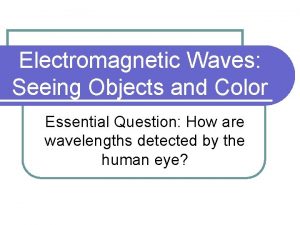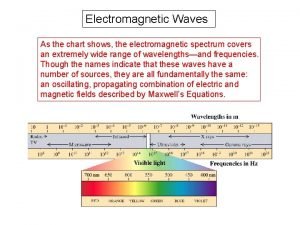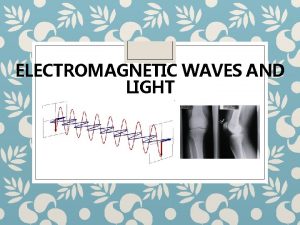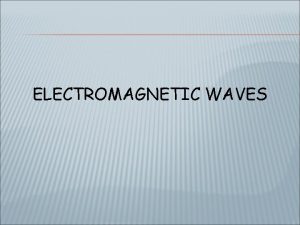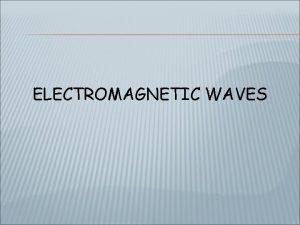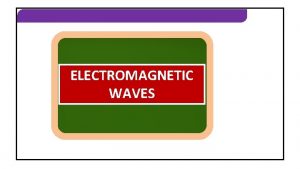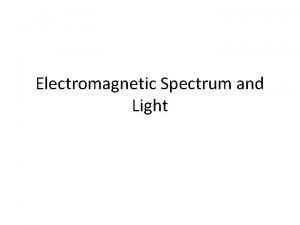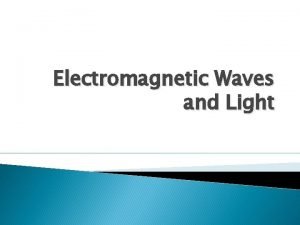Light Electromagnetic Waves Early Concepts of Light Wrong















- Slides: 15

Light & Electromagnetic Waves

Early Concepts of Light (Wrong!!) • Ancient Greece – Some believed light consisted of particles that entered the eye to produce sight – Plato & Socrates believed that eyes emitted “streamers” making contact with objects, allowing sight

Who got it right? • Greek Philosopher/Scientist, Empedocles, was the first to teach that light traveled in waves – Wave Theory was accepted by nineteenth century

Instantaneous or Finite Speed? 1675 - Danish Astronomer, Olaus Roemer was the first to demonstrate that light traveled with a finite speed!!!

How Fast? • American Physicist, Albert Michelson (1880) • Winner of the 1907 Nobel Prize • Determined speed to be 299, 920 km/s

Light Fundamentals • Light - An Example of a Transverse Wave Speed of Light 3. 0 x 108 m/s

Light Fundamentals • Light is electromagnetic radiation • Light is simply a form of Energy that travels as a transverse wave. • All electromagnetic waves travel at 3. 0 x 108 m/s • More on the Electromagnetic Spectrum

Michelson-Morely Experiment • Is the speed of light always the same? • YEP

Light Sources • Light Sources – luminous vs. illuminous • emits light vs. reflects light

Light Fundamentals • Inverse-Square Relationship – The illuminance of a body varies inversely with the square of the distance from the light source • Luminous Flux, P – rate at which light is emitted (measured in lumens, lm) • Luminous Intensity – the luminous flux that falls on one square meter

Light Fundamentals • Illuminance, E – The illuminous Intensity of a surface • Measured in lumens per square meter or a lux, lx) • E = P / 4 r 2

Light and Matter • Transparent Materials – Materials that allow light to pass through them in straight lines.

Light and Matter • Translucent Materials – Materials that transmit light but do not allow objects to be seen clearly through them.

Light and Matter • Opaque Materials – Materials that absorb or reflect light without remission and therefore allow NO light to pass through them. – Opaque materials often create shadows where light can not reach

Light and Matter • Polarization of Light – The aligning of vibrations in a transverse wave, usually by filtering out waves of other directions – 3 D movies… and other tricks… Demos
 Electromagnetic waves are transverse waves true or false
Electromagnetic waves are transverse waves true or false Similarities of mechanical and electromagnetic waves
Similarities of mechanical and electromagnetic waves Mechanical wave examples
Mechanical wave examples Similarities of mechanical waves and electromagnetic waves
Similarities of mechanical waves and electromagnetic waves Difference between matter waves and electromagnetic waves
Difference between matter waves and electromagnetic waves Examples of mechanical and electromagnetic waves
Examples of mechanical and electromagnetic waves Mechanical waves and electromagnetic waves similarities
Mechanical waves and electromagnetic waves similarities Mechanical and electromagnetic waves
Mechanical and electromagnetic waves Iambic pentameter
Iambic pentameter A health inspector is measuring the intensity of a sound
A health inspector is measuring the intensity of a sound Electromagnetic wave energy
Electromagnetic wave energy Electromagnetic waves characteristics
Electromagnetic waves characteristics Electromagnetic waves frequency
Electromagnetic waves frequency Electromagnetic waves seeing objects and color
Electromagnetic waves seeing objects and color Electro magnetic chart
Electro magnetic chart Electromagnetic waves ppt template
Electromagnetic waves ppt template









